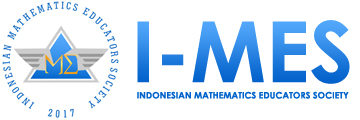Pengembangan Bahan Ajar Interaktif Berbantuan Aplikasi Book Creator dengan Model Problem Based Learning
DOI:
https://doi.org/10.35706/sjme.v8i2.11553Abstract
The objective of this research is to develop interactive learning materials supported by the Book Creator application. Leveraging advancements in information technology is essential for enhancing interactivity in school learning processes. Book Creator facilitates the creation of interactive digital books for classroom use or independent study by students. The research employed a development method, or R&D, utilizing the 4D model. The research instrument uses a questionnaire and test. Expert assessments in media, material, and practitioner confirmed the product's validity with scores of 85.5%, 85%, and 92,3%, signifying a very high validity level. The practicality and effectiveness of the product is proven through testing on students. Average score of 89% from students in limited testing. Subsequent broader testing showed an average score of 86.7%, underscoring the material's practicality. Effectiveness is seen based on the increase in the number of students who have scores above the KKM with an initial percentage of 40% to 84%, indicating that teaching materials have effective criteria.
Downloads
References
Akker, van. den. J. (1999). Principles and Methods of Development Research. In design approaches and tools in education and training (pp 1-14). Springer Netherlands. https://doi.org/10.1007/978-94-011-4255-7_1
Akmalia, A. (2022). Pengembangan Bahan Ajar E-Book Interaktif Berbantuan Book Creator pada Konsep Hukum Gravitasi Newton Terintegrasi Al-Qur’an di Ma Ittihad Al-Ummah Ussu Kabupaten Luwu Timur. Skripsi UIN Alauddin Makasar
Arifin, S., Efriani, A., & Putri, D. R. A. (2023). Pengembangan E-Modul Pengenalan Data Statistika Menggunakan Konteks Budaya Melayu Lelang Tembak. SJME (Supremum Juornal of Mathematics Education, 7(1), 107-122. https://doi.org/10.35706/sjme.v7i1.7749
Arkadiantika, I., Ramansyah, W., Effindi, M. A., & Dellia, P. (2020). Pengembangan Media Pembelajaran Virtual Reality pada Materi Pengenalan Termination dan Splicing Fiber Optic. Jurnal Dimensi Pendidikan dan Pembelajaran Universitas Muhammadiyah Ponorogo, Special Issue, SEMNASDIKJAR 2019, 29-36
Asri, Y. N. et. al. (2022). Model-Model Pembelajaran. Sukabumi: Haura Utama
Borba, M., Askar, P., Engelbrecht, J., Gadanidi, G., Llinares, S., & Aguila, M. (2017). Digital technology in mathematics education: Research over the last decade. In G. Kaiser (Ed.), Proceedings of the 13th International congress on mathematical education. ICME-13 monographs (pp. 221–233). Springer.
Bray, A., & Tangney, B. (2017). Technology usage in mathematics education research: A systematic review of recent trends. Computers & Education, 114, 255–273. https://doi.org/10.1016/j.compedu.2017.07.004
Da Silva, A. C., at. al. (2023). Book Creator: digital tool in teaching literary classics. Revista Universidade Federal de Goiás (UFG), Goiânia. DOI: 10.5216/REVUFG.V23.75994
Enawaty, E. (2023). Development of Basic Chemistry E-Module Based on Problem-Based Learning for Chemistry Education Students. Jurnal Penelitian Pendidikan IPA, 9(2), 568–573. https://doi.org/10.29303/jppipa.v9i2.2677
Estuhono, E. Friska, S. Y. & Paradila I. (2023). Pengembangan E-Modul Berbasis Research Based Learning Berbantukan Aplikasi Book Creator Pada Pembelajaran Ipas Untuk Mendukung Merdeka Belajar Siswa Sekolah Dasar. Jurnal Ika, 13(2), 112-126
Fikrah, Z., & Sukma, E. (2022). Pengembangan Bahan Ajar Digital Menggunakan Aplikasi Book Creator Pada Pembelajaran Tematik Terpadu di Kelas IV SDN 12 Air Sikambing Kabupaten Pesisir Selatan. Journal of Basic Education Studies, 5(1), 1183-1198
Hartatiana, H. & Wardani, A. K. (2024). Bagaimana Respon Siswa terhadap E-Modul Matematika dengan Konteks Budaya Sumatera Selatan?. SJME (Supremum Juornal of Mathematics Education, 8(1), 73-86, https://doi.org/10.35706/sjme.v8i1.10787
Ilyas, & Mursid. R. (2015). Pengembangan Bahan Ajar Berbasis Multimedia Interaktif Pada Pembelajaran Ketrampilan Komputer Dan Pengelolaan Informasi. Jurnal Teknologi Informasi & Komunikasi dalam Pendidikan, 2(2), 142-155
Kaplar, M. et. al. (2021). The Influence of Interactive Learning Materials on Solving Tasks That Require Different Types of Mathematical Reasoning. International Journal of Science and Mathematics Education, 411–433. https://doi.org/10.1007/s10763-021-10151-8
Karmila Putri, N. W., Candiasa, I M., & Suweken, G. (2016). Pengembangan Media Pembelajaran Transformasi Berbasis Geogebra. Jurnal Wahana Matematika dan Sains, 10(2), 25-35
Krull, G. & Duart, J.M. (2017). Research Trends in Mobile Learning in Higher Education: A Systematic Review of Articles (2011–2015). Int. Rev. Res. Open Distrib. Learn, 18, 1–23.
Kusumawati, D. dan Sutisna, A. (2021). Merdeka Belajar Dalam Konteks Kemandirian Belajar Siswa; Respon Terhadap Regulasi Baru Menteri Pendidikan Dan Kebudayaan. Jurnal Lensa Pendas, 6(1), 11-17
Majid, A. (2011). Perencanaan Pembelajaran: Mengembangkan Standar Kompetensi Guru. Bandung: Remaja Rosdakarya,
Mweene, P. & Muzaza, G. (2020). Implementation of Interactive Learning Media on Chemical Materials. Journal Educational Verkenning, 1(1), 008-013. https://hdpublication.com/index.php/jev
Palupi, D. A., Putri, K. E., & Mukmin, B. A. (2022). Pengembangan E-book menggunakan Aplikasi Book Creator berbasis QR Code pada Materi Ajar Siswa Sekolah Dasar. PTK: Jurnal Tindakan Kelas, 3(1), 78-90, https://doi.org/10.53624/ptk.v3i1.123
Pausa, Z., & Zainil, M. (2022). Pengembangan Media Pembelajaran Menggunakan Aplikasi Book Creator pada Materi Bangun Ruang di Kelas V Sekolah Dasar. e-JIPSD, 11(1), 51-64, http://dx.doi.org/10.24036/e-jipsd.v11i1
Prastyana, V., Anggoro, S., Prisilawati, D.E., Nazirah, A., & Nelson, C. (2023). Development of Canva-Based Interactive E-Book and Book Creator using the Radec Learning Model to Support Creative Thinking Skills. DINAMIKA Jurnal Ilmiah Pendidikan Dasar, 15(1), 59-65, https://doi.org/10.30595/Dinamika/v15i
Suciati, dkk. (2018). Pedoman Pengembangan Bahan Ajar Interaktif. Universitas Terbuka
Supit, D., Melianti, M., Lasut, E. M., Tumbel, N. J. (2023). Gaya Belajar Visual, Auditori, Kinestetik terhadap Hasil Belajar Siswa. Journal on Education, 05(03), 6994-7003
Thiagarajan, S., Semmel, D.S., & Semmel, M.I. (1974). Instructional development for training teacher of exceptional children. Bloomington Indiana: Indiana University.
Viberg, O., Grönlund, A., & Andersson, A. (2023). Integrating digital technology in mathematics education: a Swedish case study. Interactive Learning Environments, 31:1, 232-243, https://doi.org/10.1080/10494820.2020.1770801
Xhemajli, A. (2016). The Role of The Teacher in Interactive Teaching. (IJCRSEE) International Journal of Cognitive Research in Science, Engineering and Education, 4(1), 31-38
Xue, Y., Liu, Y., Ji, C., Xue, G. (2020). Hydrodynamic parameter identification for ship manoeuvring mathematical models using a bayesian approach. Ocean Engineering, 195: 106612. https://doi.org/10.1016/j.oceaneng.2019.106612
Yuberti. (2013). Teori Pembelajaran Dan Pengembangan Bahan Ajar Dalam Pendidikan. Lampung: Anugrah Utama Raharja.
Downloads
Published
How to Cite
Issue
Section
License

This work is licensed under a Creative Commons Attribution-ShareAlike 4.0 International License.
Authors who publish with this journal agree to the following terms:
- Authors retain copyright and grant the journal right of first publication with the work simultaneously licensed under a Creative Commons Attribution License that allows others to share the work with an acknowledgment of the work's authorship and initial publication in this journal.
- Authors are able to enter into separate, additional contractual arrangements for the non-exclusive distribution of the journal's published version of the work (e.g., post it to an institutional repository or publish it in a book), with an acknowledgment of its initial publication in this journal.
- Authors are permitted and encouraged to post their work online (e.g., in institutional repositories or on their website) prior to and during the submission process, as it can lead to productive exchanges, as well as earlier and greater citation of published work (See The Effect of Open Access).










